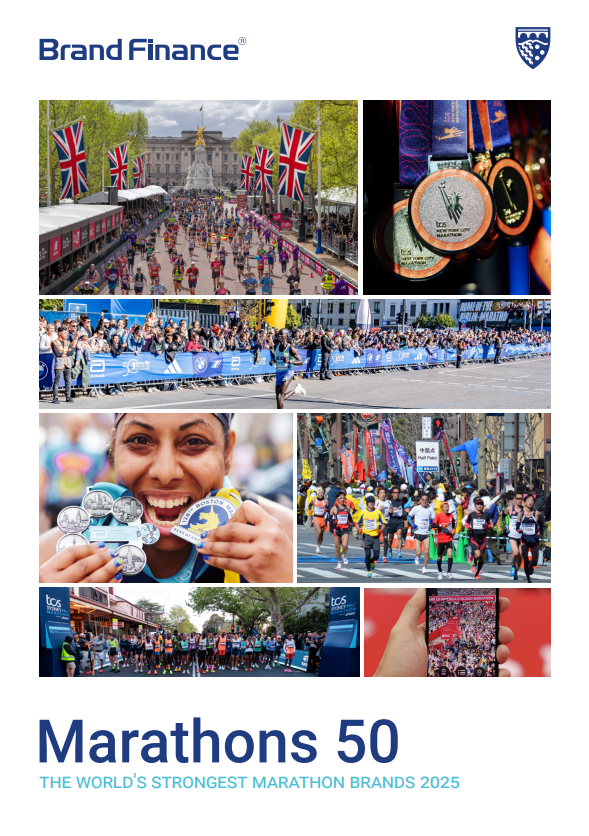This article was originally published in the Brand Finance Marathons 50 2025 report.

Head of Sports Services,
Brand Finance
Marathon sponsorships offer a rare blend of professional competition, mass public participation, and deep community engagement. Unlike many other sponsorships, they don’t just promote a brand—they become part of a city's identity, taking over its streets and bringing together diverse audiences in a shared experience. It provides brands with a distinctive platform for visibility, offering multiple levels of engagement. Some brands such as Tata Consultancy Services (TCS) take on naming rights and technical partnerships by developing race apps; while others like Nike or New Balance, concentrate on providing athletic gear for participants.
Over the years, Major marathons have attracted sponsors from industries ranging from finance, with Standard Chartered and Bank of America, to beverages, with Gatorade and Buxton water. Global marathon naming sponsors tend to be significant brands, with six out of the eight major sponsors in this article featured in Brand Finance’s ranking of the 500 most valuable brands in the world.
The underlying objective of sponsorship is to create positive perceptions and behaviours among stakeholders in a more effective and efficient way than traditional marketing tools. This is typically achieved by accessing a targeted audience and aligning with the existing attributes of the rights-holder. Exactly how this works varies depending on the brand, industry, sport/category, rights-holder, and activations. Ultimately, any partnership should deliver a return on investment, measured both in immediate sales impact and long-term brand-building benefits.
The effect of partnership activations
When evaluating sponsorships, the primary focus should extend beyond short-term gains to fostering brand recognition and long-term growth. TCS and its marathon sponsorships have significantly enhanced the company’s brand familiarity, particularly among runners. Despite being a B2B brand with lower overall familiarity, TCS has experienced the highest uplift in recognition compared to other marathon sponsors.
According to Brand Finance’s research, TCS has a familiarity of 46% amongst marathon runners versus 16% amongst non-marathon runners (Figure 1). This could be an opportunity for brands to showcase their abilities, such as TCS leveraging its app development rights to show its technological expertise, strategically engaging IT decision-makers who over-index in its audience.

In fact, the exposure is not limited to participants only, as 20% of the study participants watched a marathon just because their friends or family have taken part in it. While the exposure of some events like Formula 1 globally is higher than marathons, which have a more regionalised audience in terms of broadcast coverage, marathons are some of the largest mass participation events compared to traditional sporting events.
Participation can create new engagement channels for sponsors to reach, connect, and interact with these participants, rather than the traditional branding and exposure assets that brands unlock in other sports sponsorships. The benefits of marathon sponsorships extend beyond brand awareness to influencing consumer consideration. According to Brand Finance’s study, TCS and Standard Chartered experienced the highest surge in consideration among marathon runners. TCS, in particular, saw consideration increase from 27% amongst non-runners to 67% amongst marathon runners highlighting the strong impact of its association with the running community (Figure 2).
While brands like Nike and New Balance, which are already well-established in the sports world, naturally show smaller uplifts due to their existing reputation, TCS benefits significantly from this sponsorship strategy. Interestingly, non-endemic sponsors, those outside the sports industry, tend to see a greater uplift from their sponsorships compared to endemic brands, which already have strong associations with athletics.

Sponsoring a marathon is a marketing strategy as well as an investment in how people see a brand. These events are strongly associated with passion, hard work, and a sense of community, making them an ideal way for brands align themselves with these characteristics as well as connect emotionally with people. Sponsors also engage in creative activations, from sustainability initiatives to interactive race-day experiences that enhance fan participation.
Whether it’s through sustainability efforts, new technologies, or simply backing the runners, there is a clear uplift in perception scores amongst “Marathon Runners” and “Non-Runners” on the positive impact marathons deliver (figure 3). Alignment between sponsor and event on brand mission and attributes is a key requirement for the success of the investment.


